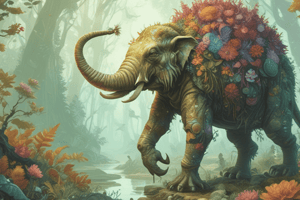Podcast
Questions and Answers
Adaptation is a process that occurs in which of the following?
Adaptation is a process that occurs in which of the following?
- Planets
- Plants (correct)
- Inanimate objects
- Rocks
What is the main purpose of adaptation?
What is the main purpose of adaptation?
- To make organisms stronger
- To help organisms survive in their environment (correct)
- To make organisms reproduce
- To make organisms look different
Which of the following is an example of adaptation?
Which of the following is an example of adaptation?
- An inanimate object changing color
- A planet rotating on its axis
- A rock changing its shape
- A plant growing towards sunlight (correct)
ما هو النبات الأكبر من حيث حجم الخشب والكتلة؟
ما هو النبات الأكبر من حيث حجم الخشب والكتلة؟
ما هو الاعتقاد الشائع حول أحجام الكائنات المدرجة في النص؟
ما هو الاعتقاد الشائع حول أحجام الكائنات المدرجة في النص؟
ما هو الهدف الرئيسي للتكيف؟
ما هو الهدف الرئيسي للتكيف؟
ما هو النبات الذي يعتبر الأكبر من حيث حجم الخشب والكتلة؟
ما هو النبات الذي يعتبر الأكبر من حيث حجم الخشب والكتلة؟
ما هي الكائنات التي يشير النص إلى أنها ذات حجم شاذ؟
ما هي الكائنات التي يشير النص إلى أنها ذات حجم شاذ؟
Flashcards are hidden until you start studying
Study Notes
Adaptation Overview
- Adaptation occurs in various biological entities, primarily organisms, to enable survival in changing environments.
- The main purpose of adaptation is to enhance reproductive success and increase chances of survival in specific habitats.
Examples of Adaptation
- Adaptations can be structural (physical characteristics), behavioral (actions taken by organisms), or physiological (internal processes), such as camouflage in animals or the ability to store water in desert plants.
Largest Plants
- The largest plant by wood volume and mass is typically the Giant Sequoia (Sequoiadendron giganteum).
- Giant Sequoias can reach heights of over 300 feet and trunk volumes exceeding 50,000 cubic feet.
Organism Size Perceptions
- Common belief often holds that larger organism sizes correlate with greater ecological dominance, although this notion can be misleading as some small organisms have significant ecological impacts.
- The passage refers to conspicuously large organisms that challenge conventional size expectations, potentially including some species of trees and marine life.
Recap on Adaptation Goals
- The primary goal of adaptation revolves around optimizing fitness within an organism's environment, ensuring better adaptation to available resources and conditions.
Noteworthy Size Anomalies
- The text indicates that certain organisms possess atypical sizes compared to their peers, highlighting unique evolutionary paths or environmental adaptations.
Studying That Suits You
Use AI to generate personalized quizzes and flashcards to suit your learning preferences.




